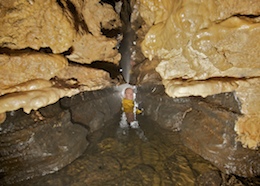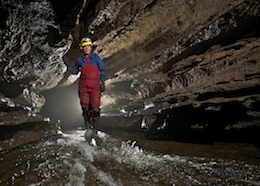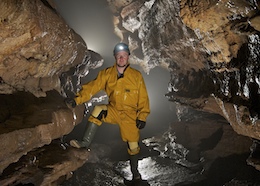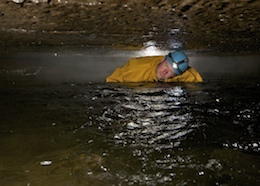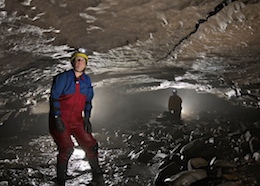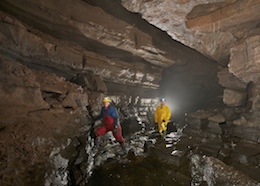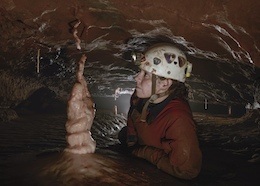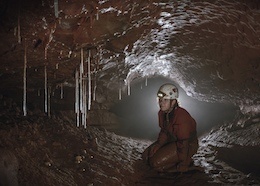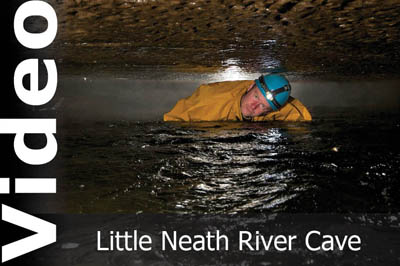Following Junction Chamber the Main Stream Passage is of grand proportions with a massive boulder, cobble and sediment bank rising on the right side of the passage. Towards the end of this bank a climb up to the top reaches a low bedding crawl over boulders that can be followed for 30m to reach the Genesis Gallery. Further upstream there is a similar bedding crawl that becomes too low after 20m. From the passage at the end of the crawl keeping high and left enters a fault controlled passage which is well decorated in places. There are a series of well decorated avens formed along the fault that you pass underneath while on the right a mud bank rises gently upwards to the flat straw covered ceiling. A small stream enters and can be followed to where the passage becomes too low to follow. Further back near the avens this passage can be regained by crawling over shingle on the right to reach the final section of the Genesis Gallery via a tight squeeze. A small shower of water enters from an aven here, which when climbed leads to the well decorated Genesis Inlet Series.
From the start of the Genesis Gallery dropping down on the right and following the low bedding controlled passages leads to the 3D Maze. This is an area of passage formed along the joints of massive fallen blocks, the gaps are tight in places and the route through this area is generally marked by a series of cairns. Progression is generally downwards and to the left until a long low bedding passage is entered via a tight upwards slot over old calcite flows. From here a cairn marks a point on the right wall where a squeeze down behind a massive block enters the Old World Series. The squeeze has to be entered with your back to the wall and your legs tuck back under yourself to enter a low passage under the wall of the passage. This is followed to quickly drop into some larger passage at a junction with some nice calcite formations and a large mud banked floor. A tiny stream flows and can be followed past the mud banks to pass a route on the left that links back around to the top of the mud banks. Beyond this junction Gooseberry Pot is reached, where to the right the passage soon closes down. To the left a passage can be dropped into, that soon reduces to a crawl. This can be followed for some distance, first quite muddy and later through standing water to end in an area of crawls that become too low.
Back at the start of the Old World Series, at the mud banked junction, a passage leads off on the left that soon becomes a hands and knees crawl. Crystal River Passage is decorated with straws in places and ends in a area where a calcite flow runs down the floor.
Overview
Little Neath River Cave affords one of the most classic dry weather caving trips in South Wales. Following water from the river through the small entrance passages coupled with the long swim through The Canal makes for an exhilarating and sporting trip. Length 8,800m
Altitude 304m
Grid SN 91180 14200
History
The cave was discovered in January 1967 by members of the University of Bristol Spelaeological Society diving the sump at the end of Bridge Cave. Tributary Passage was followed until daylight was seen, but was not passable to the surface, the cave was explored at this time to the downstream sumps. During February 1967 an underground camp enabled Flood Entrance to be opened up allowing non divers to visit this impressive cave for the first time.
Location
The cave is located in the bank of the Nedd Fechan river about 200m upstream of the bridge at the start of the Sarn Helen Road. Visit Blaen Nedd Isaf Farm first to obtain permission. A parking area is available beside Bridge Cave. Cross the Bridge and on the right a gate leads to a footpath along the west bank of the Nedd Fechan River. About 200m upstream from the bridge water runs into the cave entrance in the opposite bank of the river.Ystradfellte Google map showing the location of Little Neath River Cave and other caves in the area.
Location map - click marker to show entrance photo
Access
Permission to visit the cave must be obtained from Blaen Nedd Isaf farm, where a one pound per person trespass fee will be charged.
Description
The entrance is in the opposite side of the river and starts as a flat out crawl in water, this then becomes more hands and knees passing several right angle bends which leads to a duck after another right angle bend in the passage. Beyond the duck to the left is a route into Blaen Nedd Isaf Passage, but the way on is to follow the water to the right. The passage then continues getting narrower until you reach the top of a cascade into a small chamber. The route on is to the left over a large flat boulder following which there is a choice of tight wet duck or a climb through boulders. A climb over a rockfall leads into Tributary Passage with its flat floor and fast flowing water. Following the passage until it becomes two low a dry oxbow can be followed on the right. Back in the stream calcite flowstone is seen on the left. A short distance later a second calcite flow is seen on the left leading up to Canal Bypass Passage. Continuing to follow the streamway the passage becomes much lower before getting much larger as it enters Sand Chamber, the stream flows in the left side of the passage and to the right is a slope up to Mud Hall. Mud Hall is entered by climbing up the slope and continues as a large passage for a distance with several calcite flows in the floor and stalactites in the in the roof before it abruptly ends.
Further on in the main passage a large sand bank is found and this houses the rescue dump in case of entrapment due to flooding. Here a stream enters from the right issuing from the sump at the end of Bridge Cave. The water can be followed to the left into The Canal a 150m section of low wet passage that may sump in wet weather. At the end of The Canal a passage on the left leads to the other end of the Canal Bypass, while going downstream takes you through the large and impressive Junction Chamber, here it is possible to take an impressive view of the passage below by climbing up onto one of the several rock promontories. In the lower end of this passage you pass a climb up to the low passage that leads into the Genesis Gallery on the right.
Genesis Gallery starts as a low crawl over a cobble floor that then leads into the Genesis Gallery. The Genesis Gallery passes an area of large rectangular blocks on the right the way between is the entry to the 3D maze and then then into the Old World Series. Carrying along the left hand wall of the Genesis gallery leads to a series of avens where some fine calcite formations can be found.
Back in the main passage, further downstream a climb up on the left leads to a passage with a fine dry crystal pool that then leads two windows high above the passage opposite the Genesis Gallery. Past this passage a route along the right hand wall following the stream takes you into Bouncing Boulder Hall. Following through the Hall, the maypole entrance to the High Level Series is seen before the height of the passage reduces as you approach a duck that can sump in wet weather. Before the duck a climb up into a roof tube can be made that makes a less pleasant bypass. The streamway continues as a walking and stooping passage, passing entry to UBSS Aven on the left, Cairn Passage and Exodus Crawl on the right and finally Gryn Fawr passage on the left before Sump 2 is reached. Beyond Sump 2 are two further sumps leading into the large and extensive New World Series, a playground and reward for divers only.
Retracing your steps back at Junction Chamber you have a choice of routes, back through the Canal or straight ahead and through the Canal Bypass. Canal Bypass starts high with a sandy floor and soon an impressive calcite formation is passed just around a corner. Continuing ahead a descent is made down a slippy slope past a calcite formation to lead you into a passage with a stream in. Once in this passage the route is to follow the main passage, ignoring the side passages. Just after a waterfall is passed on the left a series of passages are encountered on the right which lead into the North East Inlet Series. This is best joined from the inlet that leads from the main bypass passage to avoid damaging the gour pools, this takes you to the passages beyond, which are a mixture of wet and dry crawls. Back on the Canal Bypass route the passage drops in height to a hands and knees crawl that gradually increases to stooping height as you reach the gour pools at the top of the calcite flow that drops you back into the main passage just before Tributary Passage.
Genesis Gallery - 3D Maze - Old World Series - Genesis Inlet
The Genesis Gallery is a series of high level passages that are located on the south side of the Main Stream Passage. On the main route a series of decorated avens formed along a fault are the most notable feature. While a descent through the 3D Maze leads via an awkward squeeze into the Old World Series.
Tackle
A wetsuit is advisable.
Video
References
Cambrian Cave Registry for Little Neath River Cave UBSS Report on the Little Neath River Cave - includes information and survey
3D survey model of Little Neath River Cave
Caves of South Wales | Tim Stratford | ISBN: 1-871890-03-9 | Published by Cordee
Selected Caves of Britain and Ireland | Des Marshall - Donald Rust | ISBN: 1-871890-43-8 | Cordee
Caves of the Little Neath Valley | Tony Oldham
Warnings
The entrance to the cave is a tight wet crawl in the river bank and floods very quickly after rain. Do not enter in wet or unsettled weather.
Disclaimer
The photographs and information of this page has been provided to help cavers planning trips. Caving can be a dangerous activity, if you are interested in exploring caves please join a caving club so you can enjoy a safe introduction to this sport. Local caving clubs are listed on the links page or you can visit the 'New To Caving' website for more options.If you feel that any of the information is incorrect or should be updated please contact us.


